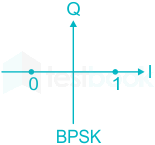In a ASK system, the amplitude of the carrier signal is 10V and t

A. {± 5V, 0, ± 5V, ± 5 V, ± 5V, ± 5V, 0, 0,…}
B. {0, ± 10V, 0, 0, 0, 0, ± 10 V, ± 10 V, …}
C. {± 10 V, 0, ± 10 V, ± 10 V, ± 10 V, ± 10 V, 0, 0, …}
D. {± 1 V, 0, ± 1 V, ± 1 V, ± 1V, ± 1V, 0, 0,…}
Please scroll down to see the correct answer and solution guide.
Right Answer is: C
SOLUTION
ASK System:
1. For ASK Transmitter on-off keying is used.
2. In Amplitude Shift Keying (ASK) binary 1 is represented with the presence of carrier and binary 0 is represented with the absence of the carrier.
1 : s1(t) = Ac cos 2πfct
0 : s2 (t) = 0


Hence,
ASK = [± 10 V, 0, ± 10 V, ± 10 V, ± 10 V, ± 10 V, 0, 0]

FSK (Frequency Shift Keying):
In FSK (Frequency Shift Keying) binary 1 is represented with a high-frequency carrier signal and binary 0 is represented with a low-frequency carrier, i.e. In FSK, the carrier frequency is switched between 2 extremes.
For binary ‘1’ → S1 (A) = Acos 2π fHt
For binary ‘0’ → S2 (t) = A cos 2π fLt . The constellation diagram is as shown:

ASK(Amplitude Shift Keying):
In ASK (Amplitude shift keying) binary ‘1’ is represented with the presence of a carrier and binary ‘0’ is represented with the absence of a carrier:
For binary ‘1’ → S1 (t) = Acos 2π fct
For binary ‘0’ → S2 (t) = 0
The Constellation Diagram Representation is as shown:

where ‘I’ is the in-phase Component and ‘Q’ is the Quadrature phase.
PSK(Phase Shift Keying):
In PSK (phase shift keying) binary 1 is represented with a carrier signal and binary O is represented with 180° phase shift of a carrier
For binary ‘1’ → S1 (A) = Acos 2π fct
For binary ‘0’ → S2 (t) = A cos (2πfct + 180°) = - A cos 2π fct
The Constellation Diagram Representation is as shown:


![For a discrete LTI system, the impulse response is u[n]. What is its s](/img/relate-questions.png)